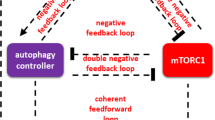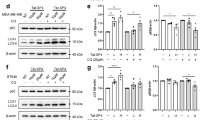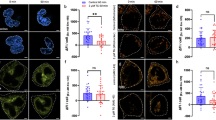Abstract
The mammalian cell death network comprises three distinct functional modules: apoptosis, autophagy and programmed necrosis. Currently, the field lacks systems level approaches to assess the extent to which the intermodular connectivity affects cell death performance. Here, we developed a platform that is based on single and double sets of RNAi-mediated perturbations targeting combinations of apoptotic and autophagic genes. The outcome of perturbations is measured both at the level of the overall cell death responses, using an unbiased quantitative reporter, and by assessing the molecular responses within the different functional modules. Epistatic analyses determine whether seemingly unrelated pairs of proteins are genetically linked. The initial running of this platform in etoposide-treated cells, using a few single and double perturbations, identified several levels of connectivity between apoptosis and autophagy. The knock down of caspase3 turned on a switch toward autophagic cell death, which requires Atg5 or Beclin-1. In addition, a reciprocal connection between these two autophagic genes and apoptosis was identified. By applying computational tools that are based on mining the protein–protein interaction database, a novel biochemical pathway connecting between Atg5 and caspase3 is suggested. Scaling up this platform into hundreds of perturbations potentially has a wide, general scope of applicability, and will provide the basis for future modeling of the cell death network.
Similar content being viewed by others
Log in or create a free account to read this content
Gain free access to this article, as well as selected content from this journal and more on nature.com
or
Abbreviations
- PCD:
-
programmed cell death
- PPI:
-
protein–protein interaction
References
Galluzzi L, Maiuri MC, Vitale I, Zischka H, Castedo M, Zitvogel L et al. Cell death modalities: classification and pathophysiological implications. Cell Death Differ 2007; 14: 1237–1243.
Shimizu S, Kanaseki T, Mizushima N, Mizuta T, Arakawa-Kobayashi S, Thompson CB et al. Role of Bcl-2 family proteins in a non-apoptotic programmed cell death dependent on autophagy genes. Nat Cell Biol 2004; 6: 1221–1228.
Yu L, Alva A, Su H, Dutt P, Freundt E, Welsh S et al. Regulation of an ATG7-beclin 1 program of autophagic cell death by caspase-8. Science 2004; 304: 1500–1502.
Zong WX, Ditsworth D, Bauer DE, Wang ZQ, Thompson CB . Alkylating DNA damage stimulates a regulated form of necrotic cell death. Genes Dev 2004; 18: 1272–1282.
Matsumura H, Shimizu Y, Ohsawa Y, Kawahara A, Uchiyama Y, Nagata S . Necrotic death pathway in Fas receptor signaling. J Cell Biol 2000; 151: 1247–1256.
Guillon-Munos A, van Bemmelen MX, Clarke PG . Role of phosphoinositide 3-kinase in the autophagic death of serum-deprived PC12 cells. Apoptosis 2005; 10: 1031–1041.
Maiuri MC, Zalckvar E, Kimchi A, Kroemer G . Self-eating and self-killing: crosstalk between autophagy and apoptosis. Nat Rev Mol Cell Biol 2007; 8: 741–752.
Chan EY, Kir S, Tooze SA . siRNA screening of the kinome identifies ULK1 as a multi-domain modulator of autophagy. J Biol Chem 2007; 282: 25464–25474.
Inbal B, Bialik S, Sabanay I, Shani G, Kimchi A . DAP kinase and DRP-1 mediate membrane blebbing and the formation of autophagic vesicles during programmed cell death. J Cell Biol 2002; 157: 455–468.
Tamm I, Wang Y, Sausville E, Scudiero DA, Vigna N, Oltersdorf T et al. IAP-family protein survivin inhibits caspase activity and apoptosis induced by Fas (CD95), Bax, caspases, and anticancer drugs. Cancer Res 1998; 58: 5315–5320.
Reef S, Zalckvar E, Shifman O, Bialik S, Sabanay H, Oren M et al. A short mitochondrial form of p19ARF induces autophagy and caspase-independent cell death. Mol Cell 2006; 22: 463–475.
Peri S, Navarro JD, Amanchy R, Kristiansen TZ, Jonnalagadda CK, Surendranath V et al. Development of human protein reference database as an initial platform for approaching systems biology in humans. Genome Res 2003; 13: 2363–2371.
Rual JF, Venkatesan K, Hao T, Hirozane-Kishikawa T, Dricot A, Li N et al. Towards a proteome-scale map of the human protein-protein interaction network. Nature 2005; 437: 1173–1178.
Stelzl U, Worm U, Lalowski M, Haenig C, Brembeck FH, Goehler H et al. A human protein-protein interaction network: a resource for annotating the proteome. Cell 2005; 122: 957–968.
Ewing RM, Chu P, Elisma F, Li H, Taylor P, Climie S et al. Large-scale mapping of human protein-protein interactions by mass spectrometry. Mol Syst Biol 2007; 3: 89.
Sharan R, Suthram S, Kelley RM, Kuhn T, McCuine S, Uetz P et al. Conserved patterns of protein interaction in multiple species. Proc Natl Acad Sci USA 2005; 102: 1974–1979.
Lord PW, Stevens RD, Brass A, Goble CA . Investigating semantic similarity measures across the Gene Ontology: the relationship between sequence and annotation. Bioinformatics 2003; 19: 1275–1283.
Moubarak RS, Yuste VJ, Artus C, Bouharrour A, Greer PA, Menissier-de Murcia J et al. Sequential activation of poly(ADP-ribose) polymerase 1, calpains, and Bax is essential in apoptosis-inducing factor-mediated programmed necrosis. Mol Cell Biol 2007; 27: 4844–4862.
Ditsworth D, Zong WX, Thompson CB . Activation of poly(ADP)-ribose polymerase (PARP-1) induces release of the pro-inflammatory mediator HMGB1 from the nucleus. J Biol Chem 2007; 282: 17845–17854.
Xu Y, Huang S, Liu ZG, Han J . Poly(ADP-ribose) polymerase-1 signaling to mitochondria in necrotic cell death requires RIP1/TRAF2-mediated JNK1 activation. J Biol Chem 2006; 281: 8788–8795.
Kabeya Y, Mizushima N, Ueno T, Yamamoto A, Kirisako T, Noda T et al. LC3, a mammalian homologue of yeast Apg8p, is localized in autophagosome membranes after processing. EMBO J 2000; 19: 5720–5728.
Gozuacik D, Kimchi A . Autophagy and cell death. Curr Top Dev Biol 2007; 78: 217–245.
St Onge RP, Mani R, Oh J, Proctor M, Fung E, Davis RW et al. Systematic pathway analysis using high-resolution fitness profiling of combinatorial gene deletions. Nat Genet 2007; 39: 199–206.
Pyo JO, Jang MH, Kwon YK, Lee HJ, Jun JI, Woo HN et al. Essential roles of Atg5 and FADD in autophagic cell death: dissection of autophagic cell death into vacuole formation and cell death. J Biol Chem 2005; 280: 20722–20729.
Yousefi S, Perozzo R, Schmid I, Ziemiecki A, Schaffner T, Scapozza L et al. Calpain-mediated cleavage of Atg5 switches autophagy to apoptosis. Nat Cell Biol 2006; 8: 1124–1132.
Lee JC, Schickling O, Stegh AH, Oshima RG, Dinsdale D, Cohen GM et al. DEDD regulates degradation of intermediate filaments during apoptosis. J Cell Biol 2002; 158: 1051–1066.
Mircescu H, Steuve S, Savonet V, Degraef C, Mellor H, Dumont JE et al. Identification and characterization of a novel activated RhoB binding protein containing a PDZ domain whose expression is specifically modulated in thyroid cells by cAMP. Eur J Biochem 2002; 269: 6241–6249.
Segre D, Deluna A, Church GM, Kishony R . Modular epistasis in yeast metabolism. Nat Genet 2005; 37: 77–83.
Tong AH, Lesage G, Bader GD, Ding H, Xu H, Xin X et al. Global mapping of the yeast genetic interaction network. Science 2004; 303: 808–813.
Schuldiner M, Collins SR, Thompson NJ, Denic V, Bhamidipati A, Punna T et al. Exploration of the function and organization of the yeast early secretory pathway through an epistatic miniarray profile. Cell 2005; 123: 507–519.
Stuart A, Ord JK . Kendall's Advanced Theory of Statistics. 5 edn. Oxford University Press, Inc. New York, NY, USA, 1987; 1: pp.325.
Whitlock MC . Combining probability from independent tests: the weighted Z-method is superior to Fisher's approach. J Evol Biol 2005; 18: 1368–1373.
Shachar R, Ungar L, Kupiec M, Ruppin E, Sharan R . A systems-level approach to mapping the telomere length maintenance gene circuitry. Mol Syst Biol 2008; 4: 172.
Acknowledgements
We thank Helena Sabanay for her assistance in performing the TEM experiments, Sara Barak for performing the antiviral response assay, and Yulia Idelchuk for essential technical help. We thank Yitzhak Pilpel for fruitful discussions and for commenting on the manuscript, Edna Schechtman for help and advice in statistical analysis and Z Kam for the help in setting up the live imaging system. We thank N Mizushima and T Yoshimori for providing the GFP-LC3 plasmid, YK Jung for the Atg5-HA plasmid, ME Peter for the Flag-DEDD plasmid and Y Lazebnik for providing anti-Caspase9 and anti-Caspase7 antibodies. This work was supported by the Kahn Fund for System Biology at the Weizmann Institute of Science and by the EU grant (APO-SYS) to A Kimchi. A Kimchi is the incumbent of the Helena Rubinstein Chair of Cancer Research. R Sharan and E Ruppin were supported by a converging technologies grant from the Israel Science Foundation.
Author information
Authors and Affiliations
Corresponding author
Ethics declarations
Competing interests
The authors declare no conflict of interest.
Additional information
Edited by G Melino
Supplementary Information accompanies the paper on Cell Death and Differentiation website
Rights and permissions
About this article
Cite this article
Zalckvar, E., Yosef, N., Reef, S. et al. A systems level strategy for analyzing the cell death network: implication in exploring the apoptosis/autophagy connection. Cell Death Differ 17, 1244–1253 (2010). https://doi.org/10.1038/cdd.2010.7
Received:
Revised:
Accepted:
Published:
Issue date:
DOI: https://doi.org/10.1038/cdd.2010.7
Keywords
This article is cited by
-
Pharmacological exploitation of the phenothiazine antipsychotics to develop novel antitumor agents–A drug repurposing strategy
Scientific Reports (2016)
-
The small molecule TGF-β signaling inhibitor SM16 synergizes with agonistic OX40 antibody to suppress established mammary tumors and reduce spontaneous metastasis
Cancer Immunology, Immunotherapy (2012)
-
Conversation between apoptosis and autophagy: “Is it your turn or mine?”
Apoptosis (2011)
-
Integrative systems biology and networks in autophagy
Seminars in Immunopathology (2010)



